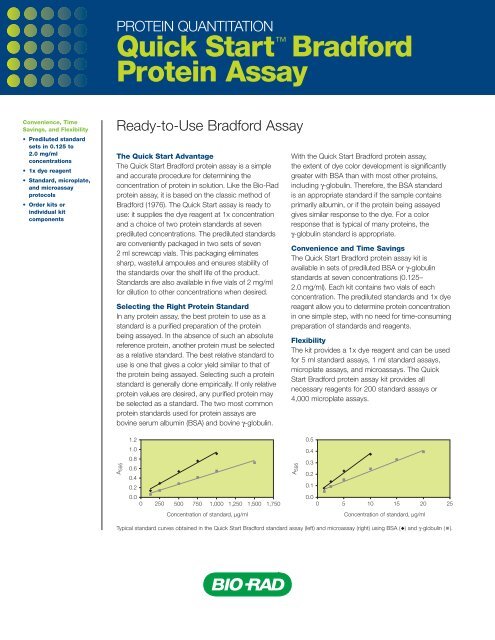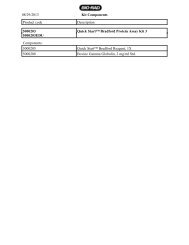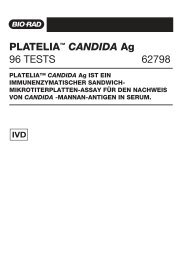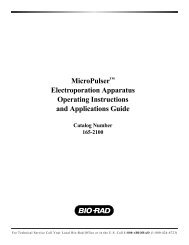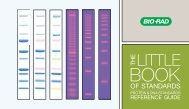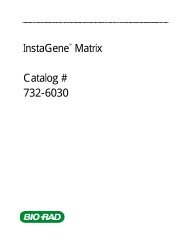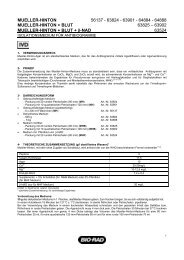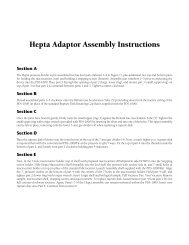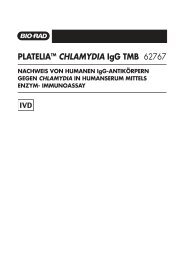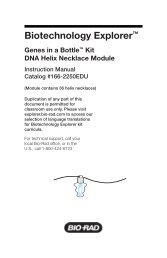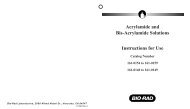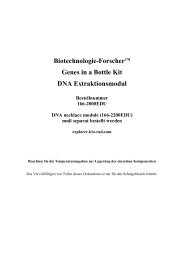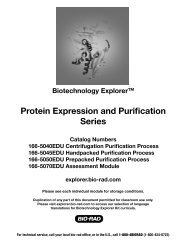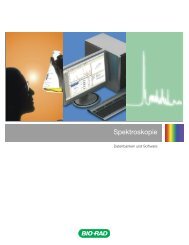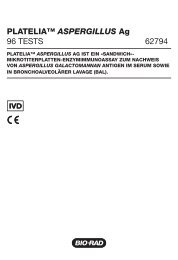Quick Start™ Bradford Protein Assay - Bio-Rad
Quick Start™ Bradford Protein Assay - Bio-Rad
Quick Start™ Bradford Protein Assay - Bio-Rad
Create successful ePaper yourself
Turn your PDF publications into a flip-book with our unique Google optimized e-Paper software.
Convenience, Time<br />
Savings, and Flexibility<br />
• Prediluted standard<br />
sets in 0.125 to<br />
2.0 mg/ml<br />
concentrations<br />
• 1x dye reagent<br />
• Standard, microplate,<br />
and microassay<br />
protocols<br />
• Order kits or<br />
individual kit<br />
components<br />
PROTEIN QUANTITATION<br />
<strong>Quick</strong> Start <strong>Bradford</strong><br />
<strong>Protein</strong> <strong>Assay</strong><br />
Ready-to-Use <strong>Bradford</strong> <strong>Assay</strong><br />
The <strong>Quick</strong> Start Advantage<br />
The <strong>Quick</strong> Start <strong>Bradford</strong> protein assay is a simple<br />
and accurate procedure for determining the<br />
concentration of protein in solution. Like the <strong>Bio</strong>-<strong>Rad</strong><br />
protein assay, it is based on the classic method of<br />
<strong>Bradford</strong> (1976). The <strong>Quick</strong> Start assay is ready to<br />
use: it supplies the dye reagent at 1x concentration<br />
and a choice of two protein standards at seven<br />
prediluted concentrations. The prediluted standards<br />
are conveniently packaged in two sets of seven<br />
2 ml screwcap vials. This packaging eliminates<br />
sharp, wasteful ampoules and ensures stability of<br />
the standards over the shelf life of the product.<br />
Standards are also available in five vials of 2 mg/ml<br />
for dilution to other concentrations when desired.<br />
Selecting the Right <strong>Protein</strong> Standard<br />
In any protein assay, the best protein to use as a<br />
standard is a purified preparation of the protein<br />
being assayed. In the absence of such an absolute<br />
reference protein, another protein must be selected<br />
as a relative standard. The best relative standard to<br />
use is one that gives a color yield similar to that of<br />
the protein being assayed. Selecting such a protein<br />
standard is generally done empirically. If only relative<br />
protein values are desired, any purified protein may<br />
be selected as a standard. The two most common<br />
protein standards used for protein assays are<br />
bovine serum albumin (BSA) and bovine γ-globulin.<br />
A 595<br />
1.2<br />
1.0<br />
0.8<br />
0.6<br />
0.4<br />
0.2<br />
With the <strong>Quick</strong> Start <strong>Bradford</strong> protein assay,<br />
the extent of dye color development is significantly<br />
greater with BSA than with most other proteins,<br />
including γ-globulin. Therefore, the BSA standard<br />
is an appropriate standard if the sample contains<br />
primarily albumin, or if the protein being assayed<br />
gives similar response to the dye. For a color<br />
response that is typical of many proteins, the<br />
γ-globulin standard is appropriate.<br />
Convenience and Time Savings<br />
The <strong>Quick</strong> Start <strong>Bradford</strong> protein assay kit is<br />
available in sets of prediluted BSA or γ-globulin<br />
standards at seven concentrations (0.125–<br />
2.0 mg/ml). Each kit contains two vials of each<br />
concentration. The prediluted standards and 1x dye<br />
reagent allow you to determine protein concentration<br />
in one simple step, with no need for time-consuming<br />
preparation of standards and reagents.<br />
Flexibility<br />
The kit provides a 1x dye reagent and can be used<br />
for 5 ml standard assays, 1 ml standard assays,<br />
microplate assays, and microassays. The <strong>Quick</strong><br />
Start <strong>Bradford</strong> protein assay kit provides all<br />
necessary reagents for 200 standard assays or<br />
4,000 microplate assays.<br />
0.0 0.0<br />
0 250 500 750 1,000 1,250 1,500 1,750<br />
0 5 10 15 20 25<br />
Typical standard curves obtained in the <strong>Quick</strong> Start <strong>Bradford</strong> standard assay (left) and microassay (right) using BSA (◆) and γ-globulin ( ■ ).<br />
A 595<br />
Concentration of standard, µg/ml Concentration of standard, µg/ml<br />
0.5<br />
0.4<br />
0.3<br />
0.2<br />
0.1
Reagents compatible with the <strong>Quick</strong> Start <strong>Bradford</strong> protein assay.<br />
Acetone, 10%<br />
Acetonitrile, 10%<br />
Ammonium sulfate, 1 M<br />
Ampholytes, pH 3–10, 0.5%<br />
ASB-14, 0.025%<br />
Ascorbic acid, 50 mM<br />
Bis-Tris, pH 6.5, 0.2 M<br />
β-Mercaptoethanol, 1 M<br />
Calcium chloride, 40 mM<br />
CHAPS, 10%<br />
CHAPSO, 10%<br />
Deoxycholic acid, 0.2%<br />
Dithioerythritol (DTE), 10 mM<br />
Dithiothreitol (DTT), 10 mM<br />
DMSO, 5%<br />
Eagle’s MEM<br />
Earle’s salt solution<br />
EDTA, 0.2 M<br />
EGTA, 0.2 M<br />
Ethanol, 10%<br />
Glucose, 20%<br />
Glycerol, 5%<br />
Glycine, 0.1 M<br />
Guanidine-HCl, 2 M<br />
Hank’s salt solution<br />
HCI, 0.1 M<br />
HEPES, 0.1 M<br />
Imidazole, 0.2 M<br />
Magnesium chloride, 1 M<br />
MES, 0.1 M<br />
Methanol, 10%<br />
Modified Dulbecco’s PBS<br />
MOPS, 0.1 M<br />
NAD, 2 mM<br />
Life Science<br />
Group<br />
Bulletin 2969 US/EG Rev A<br />
Nonidet P-40, 0.25%<br />
Octylglucoside, 0.5%<br />
Octyl β-thioglucopyranoside, 1%<br />
PBS<br />
Phenol Red, 0.5 mg/ml<br />
PIPES, 0.2 M<br />
PMSF, 2 mM<br />
Potassium chloride, 2 M<br />
Potassium phosphate, 0.5 M<br />
SB 3–10, 0.1%<br />
SDS, 0.025%<br />
Sodium acetate, pH 4.8, 0.2 M<br />
Sodium azide, 0.5%<br />
Sodium bicarbonate, 0.2 M<br />
Sodium carbonate, 0.1 M<br />
Sodium chloride, 2.5 M<br />
Sodium citrate, pH 4.8 or 6.4, 0.2 M<br />
Sodium hydroxide, 0.1 M<br />
Sodium phosphate, 0.5 M<br />
Sucrose, 10%<br />
Tributylphosphine (TBP), 5 mM<br />
TBS (25 mM Tris, 0.15 M NaCl, pH 7.6), 0.5x<br />
TCEP, 20 mM<br />
Thiourea, 1 M<br />
Tricine, pH 8, 50 mM<br />
Triethanolamine, pH 7.8, 50 mM<br />
Tris, 1 M<br />
Tris-glycine (25 mM Tris, 192 mM glycine)<br />
Tris-glycine-SDS (25 mM Tris, 192 mM glycine,<br />
0.1% SDS), 0.5x<br />
Triton X-100, 0.05%<br />
Tween 20, 0.01%<br />
Urea, 4 M<br />
Triton is a trademark of Union Carbide. Tween is a trademark of ICI Americas, Inc.<br />
Disposable Cuvettes<br />
Disposable cuvettes are ideal for protein assays.<br />
Optically clear on two sides, disposable<br />
cuvettes can be used as mixing vessels and<br />
then used directly in the spectrophotometer.<br />
<strong>Bio</strong>-<strong>Rad</strong><br />
Laboratories, Inc.<br />
Kit Components<br />
<strong>Quick</strong> Start <strong>Bradford</strong> protein assay kits are available with a<br />
combination of the components below. See ordering information<br />
for a list of components belonging to each kit. Each component<br />
and reagent has a 1-year shelf life at 4°C, and can be<br />
purchased separately.<br />
<strong>Quick</strong> Start 1x dye reagent — 1 L of dye solution containing<br />
methanol and phosphoric acid. One bottle of dye reagent is<br />
sufficient for 200 assays using the standard 5 ml procedure<br />
or 4,000 assays using the microplate procedure.<br />
BSA standard, 2 mg/ml — 5 x 2 ml vials containing BSA.<br />
Bovine γ-globulin standard, 2 mg/ml — 5 x 2 ml vials<br />
containing γ-globulin.<br />
BSA standard set — 2 x 2 ml vials of standard at each<br />
concentration. Set contains seven concentrations of BSA<br />
(2, 1.5, 1, 0.75, 0.5, 0.25, and 0.125 mg/ml).<br />
Bovine γ-globulin standard set — 2 x 2 ml vials of standard<br />
at each concentration. Set contains seven concentrations of<br />
γ-globulin (2, 1.5, 1, 0.75, 0.5, 0.25, and 0.125 mg/ml).<br />
All standards are provided in a solution of 0.9% NaCl and<br />
0.05% NaN 3 .<br />
Reference<br />
<strong>Bradford</strong> MM, A rapid and sensitive method for the quantitation of microgram<br />
quantities of protein utilizing the principle of protein-dye binding, Anal <strong>Bio</strong>chem<br />
72, 248–254 (1976)<br />
Ordering Information<br />
Catalog# Description<br />
500-0201 <strong>Quick</strong> Start <strong>Bradford</strong> <strong>Protein</strong> <strong>Assay</strong> Kit 1, includes<br />
1 L 1x dye reagent, BSA standard (5 x 2 mg/ml)<br />
500-0202 <strong>Quick</strong> Start <strong>Bradford</strong> <strong>Protein</strong> <strong>Assay</strong> Kit 2, includes<br />
1 L 1x dye reagent, BSA standard set (14 x 2 ml<br />
of 0.125–2.0 mg/ml)<br />
500-0203 <strong>Quick</strong> Start <strong>Bradford</strong> <strong>Protein</strong> <strong>Assay</strong> Kit 3, includes<br />
1 L 1x dye reagent, bovine γ-globulin standard<br />
(5 x 2 mg/ml)<br />
500-0204 <strong>Quick</strong> Start <strong>Bradford</strong> <strong>Protein</strong> <strong>Assay</strong> Kit 4, includes<br />
1 L 1x dye reagent, bovine γ-globulin standard set<br />
(14 x 2 ml of 0.125–2.0 mg/ml)<br />
500-0205 <strong>Quick</strong> Start 1x Dye Reagent, 1 L<br />
500-0206 <strong>Quick</strong> Start Bovine Serum Albumin Standard,<br />
5 x 2 ml vials of 2 mg/ml<br />
500-0207 <strong>Quick</strong> Start Bovine Serum Albumin Standard Set,<br />
2 sets of 7 concentrations (2, 1.5, 1, 0.75, 0.5, 0.25,<br />
0.125 mg/ml) in 2 ml vials<br />
500-0208 <strong>Quick</strong> Start Bovine γ-Globulin Standard, 5 x 2 ml<br />
vials of 2 mg/ml<br />
500-0209 <strong>Quick</strong> Start Bovine γ-Globulin Standard Set, 2<br />
sets of 7 concentrations (2, 1.5, 1, 0.75, 0.5, 0.25,<br />
0.125 mg/ml) in 2 ml vials<br />
223-9950 Standard Disposable Polystyrene Cuvettes, 3.5 ml, 100<br />
223-9955 Semimicro Disposable Polystyrene Cuvettes, 1.5 ml, 100<br />
Web site www.bio-rad.com USA (800) 4BIORAD Australia 02 9914 2800 Austria (01)-877 89 01 Belgium 09-385 55 11 Brazil 55 21 507 6191<br />
Canada (905) 712-2771 Czech Republic + 420 2 41 43 05 32 China (86-21) 63052255 Denmark 44 52 10 00 Finland 09 804 22 00<br />
France 01 47 95 69 65 Germany 089 318 84-177 Hong Kong 852-2789-3300 India (91-124)-6398112/113/114, 6450092/93 Israel 03 951 4127<br />
Italy 39 02 216091 Japan 03-5811-6270 Korea 82-2-3473-4460 Latin America 305-894-5950 Mexico 52 5 534 2552 to 54<br />
The Netherlands 0318-540666 New Zealand 64 9 415 2280 Norway 23 38 41 30 Poland + 48 22 331 99 99 Portugal 351-21-472-7700<br />
Russia 7 095 721 1404 Singapore 65-6415 3188 South Africa 00 27 11 4428508 Spain 34 91 590 5200 Sweden 08 555 12700<br />
Switzerland 061 717-9555 Taiwan (8862) 2578-7189/2578-7241 United Kingdom 020 8328 2000<br />
03-219 0603 Sig 0303


